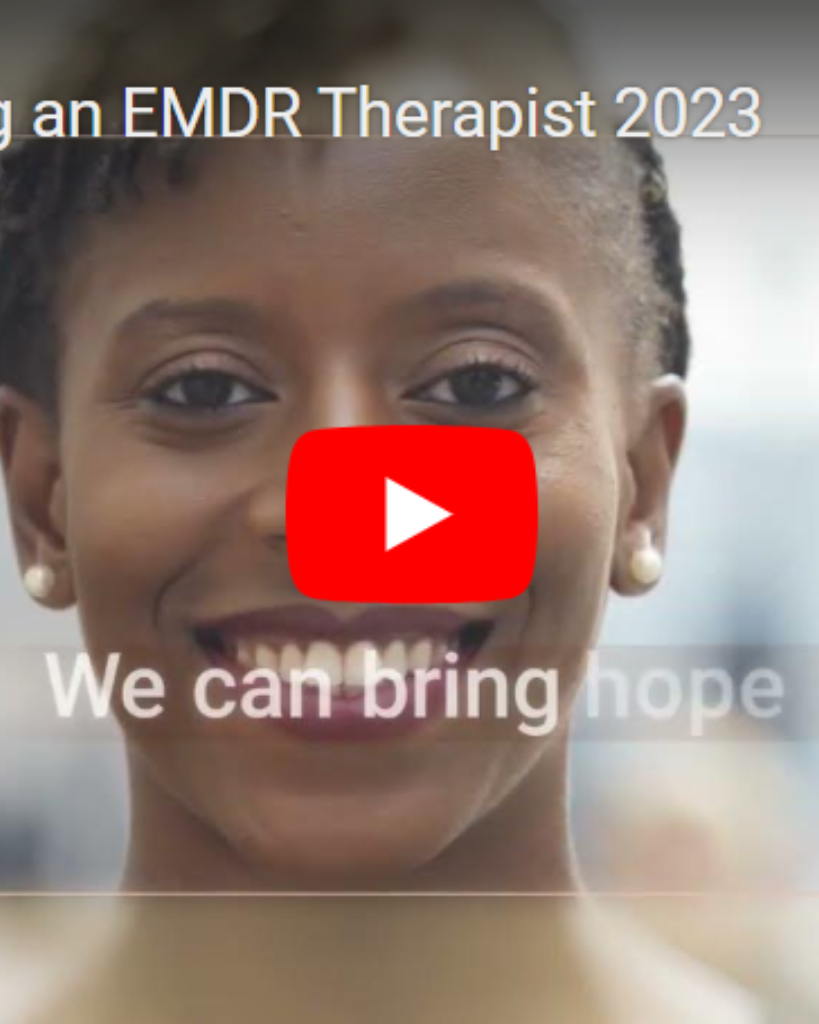Are you wondering “should I become an EMDR therapist?” Discover how you can help your clients with EMDR therapy in this video featuring:
- Rick Levinson, LCSW, EMDR Therapist, Consultant, and Trainer
- William Henry Petty, PhD, Director, Victim Services Unit, Houston Police Department
- Marisol Solarte-Erlacher, MA, LPC, EMDR Therapist, Consultant, and Trainer
- Wendy L. Byrd, LPC, LMFT, President, EMDRIA
- Susanna Kaufman, MA, NCC, LPC Associate, EMDR Therapist
- Rochelle Hoffler, LCSW, EMDR Therapist and Consultant
Transcript
[Music]
0:05
[Levinson]
There’s so much trauma worldwide and here it is that we have this ability to so effectively and efficiently treat trauma.
0:20
[Petty]
I have encountered lots of people with lots of different problems who’ve gone to therapy using lots of different ways. Out of all those, one that I found to be the most effective has been EMDR treatment, bar none.
0:37
[Solarte-Erlacher]
You have clients who go from complete disbelief to I don’t know how this happened, I don’t know how you did it, but it worked.
0:48
[Byrd]
My experience is most new clinicians go I’m so excited to learn this, I’m so excited to implement it, but I want support, I want resources, where am I going to find that, where’s my home, and that’s what we’re trying to provide them.
1:03
[Kaufman]
EMDRIA kind of sets the bar as far as the standards for EMDR therapy. You know it’s a 50 hour training, it’s no joke. 20 hours of the class work, 20 hours of the practicum, and the 10 hours of consultation, you come out with a very thorough knowledge of EMDR therapy and those are the EMDRIA trainings.
1:24
[Byrd]
You can find community, you can find continuing education, you can find support, you stay up to date on the latest research.
1:31
[Hoffler]
There’s an entire community there that you can connect to so you don’t have to feel like you’re by yourself out there doing this.
1:39
[Byrd]
You’ll find new clinicians who are just like you and you’ll find clinicians who have been practicing EMDR for 25 years and can give you enormous amounts of experience and wisdom.
1:50
[Hoffler]
I couldn’t make this information work for my clients without some help, without consultation, without community. And I think that’s still important even now, you know I’m five years in, I still have people that I will staff cases with, that I will, you know, consult with.
2:07
[Kaufman]
It was nerve-wracking to go to the EMDR training. You’re just going into this training knowing you’re going to learn something brand new that is a totally different type of therapy than you’re used to.
2:18
[Hoffler]
My advice would be lean into that discomfort because that’s where the learning can happen. Everybody’s going through it, it will get better, you will feel more comfortable, don’t give up.
2:33
[Kaufman]
One of the reassuring things that I realized during the training is that I already knew as a trauma therapist a lot of what I was learning in the EMDR training.It’s just sticking the skills that I knew into the EMDR therapy phases.
2:50
[Hoffler]
You know I think a tipping point came for me when I was able to go through the phases of the treatment and identify for my consultant what was happening in each phase and I just got confirmation from her. She’s like yeah that’s exactly right, this is exactly what it’s supposed to do and of course seeing my client recover and the relief that comes over their face, it’s incredible. I still get excited at the prospect of seeing that relief.
3:32
[Kaufman]
So the trajectory of an EMDR therapist is you get your first initial training, you typically join EMDRIA at that point so that you are involved in the larger community of EMDR therapists. Then you have the opportunity to work towards EMDR certification, and then you can even go beyond that become an EMDR approved consultant, and then if you want you can also become an EMDR trainer.
3:47
[Hoffler]
The more advanced trainings you do, the more you start to realize that there’s an art to this and it’s not just this one regimented thing there are many ways to kind of explore using different protocols for different presentations. I will forever be a student of this.
4:09
[Byrd]
There’s no lack of pain in the world and challenges and traumas that we can experience as humans. When we heal from the experiences that we’ve had, then we create health within ourselves, within our communities, within our families. we can bring hope for reaching a potential that all people deserve to have. Welcome.
Date
December 11, 2023
Creator(s)
EMDR International Association
Contributor(s)
Rick Levinson, William Henry Petty, Marisol Solarte-Erlacher, Wendy L. Byrd, Susanna Kaufman, Rochelle Hoffler
Practice & Methods
Your EMDR Practice
Extent
4 minutes
Publisher
EMDR International Association
Rights
Copyright © 2022 EMDR International Association
APA Citation
EMDR International Association. (2023, December 11). Becoming an EMDR therapist [Video]. YouTube. https://youtu.be/W3hDfWVtz18
Audience
Other Mental Health Professionals
Language
English
Content Type
Video
Original Source
EMDRIA YouTube
Access Type
Open Access





